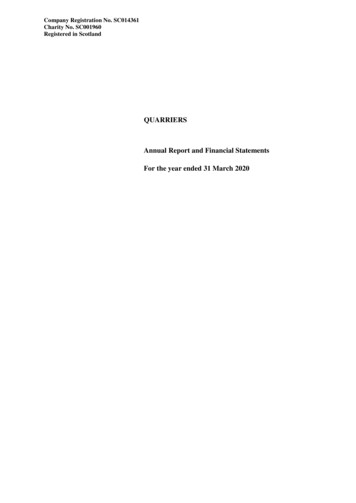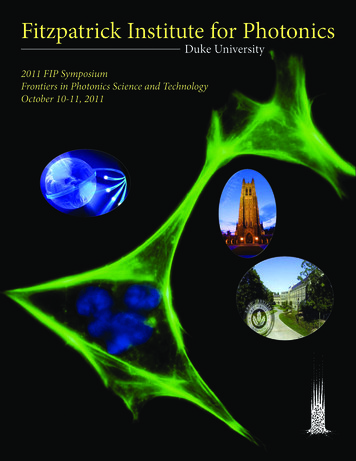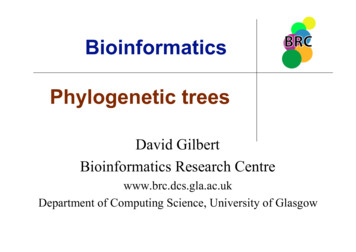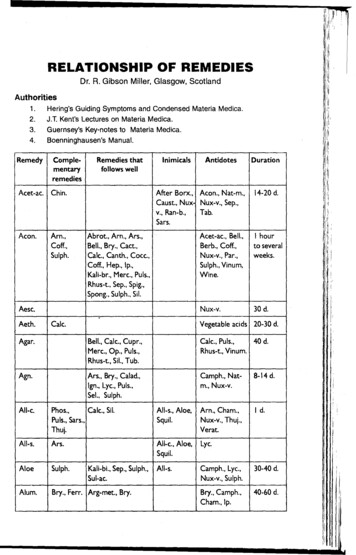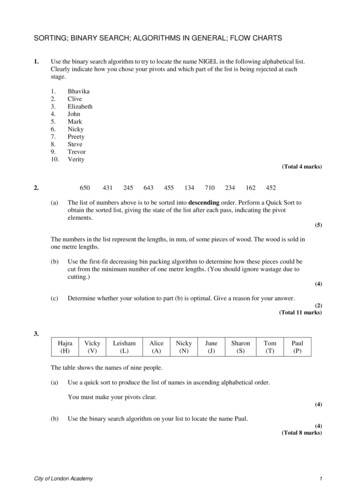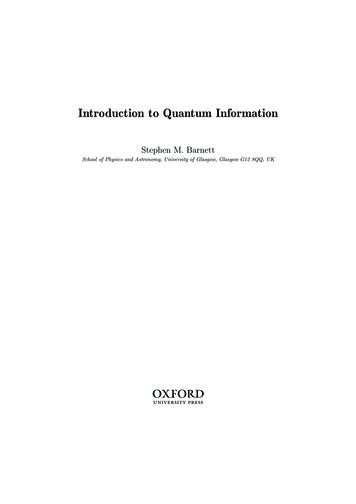
Transcription
Introduction to Quantum InformationStephen M. BarnettSchool of Physics and Astronomy, University of Glasgow, Glasgow G12 8QQ, UK1
Contents1123481Classical Information Theory1.1 A very short history1.2 Probabilities and conditional probabilities1.3 Entropy and information1.4 Information and thermodynamics1.5 Communications Theory2Quantum Communications and Quantum Key Distribution2.1 Qubits2.2 Information security2.3 Quantum copying?2.4 Optical polarization2.5 Quantum cryptography1111121516163Generalized Measurements3.1 Ideal von Neumann measurements3.2 Non-ideal measurements3.3 Probability operator measures3.4 Optimized measurements3.5 Operations and the post-measurement state2121232326314Entanglement and its Applications4.1 Entangled states and non-locality4.2 Quantum “magic tricks”4.3 Ebits and shared entanglement4.4 Quantum dense coding4.5 Teleportation3333373839415Quantum Computation5.1 Digital electronics5.2 Quantum gates5.3 Principles of quantum computation5.4 Quantum algorithms5.5 Errors and decoherence444445485255References57
1Classical Information TheoryIn these five lectures I shall give a short introduction to the field of quantuminformation. The lectures are drawn from my book Quantum Information (Barnett2009). My aim is to make these notes self-contained, but cannot hope to cover thetotality of what is now a large and active field of research. In these notes I aim, rather,to give a taster of the subject to whet the appetite of the reader. A more completeintroduction may be found in (Barnett 2009) or in any of a now large collection ofbooks and review papers devoted to the topic (far too may for me to attempt to makea list and to risk offence by innocent omission). One text that needs to be mentioned,however, is that by Nielsen and Chuang (2000), which did so much both to popularisethe field and to lay out its founding principles.I am grateful to Oxford University Press for their permission and, indeed, encouragement to reproduce some of the material from (Barnett 2009). I wish to express alsomy gratitude to Allison Yao for her help in preparing these notes.1.1A very short historyOur field starts with the work of the Reverend Thomas Bayes (1702–1761) and thecelebrated theorem that bears his name (of which more below) (Bayes 1763). Hiskey idea was that probabilities depend on what you know; if we acquire additionalinformation then this modifies the probabilities. Today such reasoning is uncontentiousand forms part of the prevailing paradigm in much of probability theory (Jeffreys, 1939;Box and Tiao 1973; Bretthorst 1988; Lee 1989; Jaynes 2003). This was not the case,however, for most of the 350 years of its history. An entertaining and informativepresentation of its troubled history may be found in (Mcgrayne 2011).The picture is completed by identifying, or formulating the quantity of information.It was Claude Shannon (1916–2001) who solved this problem and, by using it to devisehis two coding theorems, founded information theory (Shannon 1948). Perhaps I cangive an indication of the magnitude of Shannon’s achievement by relating that the titleof his paper was A Mathematical Theory of Communication, but a year later the paperwas republished as a book (Shannon and Weaver 1949); apart from correcting a fewtypographical errors, there are only two changes, the inclusion of a short introductoryarticle by Weaver and a change of title to The Mathematical Theory of Communication.The theory was born complete, the numerous textbooks on the topic have greatlybroadened the scope and application of Shannon’s ideas but have not departed fromthe fundamentals as explained by Shannon in his first paper (Brillouin 1956; Khinchin1957; Kullback 1959; Hamming 1980; Cover and Thomas 1991; Goldie and Pinch 1991).
2Classical Information TheoryShannon’s information has a simple and familiar form. For a given set of probabilities {pi }, the information isXpi log pi .(1.1)H iRemarkably, this is simply Boltzmann’s formula for the entropy (of which more later).We can sum up the fundamental lessons learned from Bayes and from Shannonas follows: Bayes taught us that probabilities are not absolute but rather depend onavailable information. Shannon showed that information itself is a precisely definedfunction of the probabilities.Shannon’s work was aimed, initially, at the problem of providing a quantitativetheory of communications, but any set of probabilities can be associated with a quantity of information and it follows that any probabilistic phenomenon has an associatedinformation theory. This idea has been applied, for example, to statistical mechanics(Jaynes 1957a, 1957b). Quantum theory is a probabilistic theory, of course, and so itwas inevitable that a quantum information theory would be developed.1.2Probabilities and conditional probabilitiesConsider an event A with possible outcomes {ai }. Everything we know is specifiedby the probabilities for the possible outcomes: {P (ai )}. For tossing a fair coin, forexample, the outcomes are ‘heads’ and ‘tails’ with P (heads) 12 P (tails). In generalthe probabilities satisfy the two conditions0 P (ai ) 1XP (ai ) 1 .(1.2)iIf we have two events A and B with outcomes {ai } and {bj } then the completedescription is given by the joint probabilities, P (ai , bj ). Here the comma is read as‘and’ so that P (ai , bj ) is the probability that both A ai and B bj . If the twoevents are independent then P (ai , bj ) P (ai )P (bj ) but this is not true in general.More generally we haveXP (ai , bj )P (ai ) jP (bj ) XP (ai , bj ) .(1.3)iIf the events are created then what does learning the value of A tell us about thevalue of B? If we learn, for example, that A a0 then P (bj ) is replaced byP (bj a0 ) P (a0 , bj ) .(1.4)Here the vertical line is read as ‘given that’ so that P (bj a0 ) is the probability thatB bj given that A a0 . We can find the constant of proportionality by noting thatthe sum over j of P (bj a0 ) must be unity and this leads to Bayes’ rule:P (ai , bj ) P (bj ai )P (ai )
Entropy and information P (ai bj )P (bj ) .3(1.5)Bayes’ theorem utilises this rule to relate the two conditional probabilities:P (ai bj ) 1.3P (bj ai )P (ai ).P (bj )(1.6)Entropy and informationThe link between information and entropy is a subtle and beautiful one. Shannonhimself gave a simple derivation of this as a mathematical theorem using only a fewsimple axioms he argued that information must satisfy (Shannon and Weaver 1949).We shall not reproduce this here bust rather present a simple argument to make theassociation plausible.Suppose that we have a single event A with possible outcomes ai . If one, say a0 , iscertain to occur then we acquire no information by observing A. By simple extension,if A a0 is very likely to occur then we might confidently expect it and so when ithappens we learn very little. If, however, A a0 is very unlikely then when it occurswe might need to drastically modify our actions. A very simple example is a two-statecommunication system that you may not have considered: a fire alarm. A fire alarmis either ringing or not ringing. Its most common state (hopefully not ringing) is soinnocuous that we give it no thought. When it does ring, however, we stop what weare doing and leave the building (if we are sensible).It seems reasonable to conclude that learning the value of A provides a quantityof information, h, that increases as the corresponding probability decreases:h[P (ai )] as P (ai ) .We think of learning something new as adding to the available information. Thereforefor independent probabilities for a pair of events, P (ai , bj ) P (ai )P (bj ), it is naturalto require thath[P (ai , bj )] h[P (ai )P (bj )] h[P (ai )] h[P (bj ) ,(1.7)which immediately suggests logarithms. Hence we seth[P (ai )] K log P (ai ) .(1.8)Here K is a positive constant, yet to be determined, and the minus sign ensures boththat h is positive and that it increases as the probability decreases (recall that thelogarithm of a number less than unity is negative).It is convenient to define the information as the average of h, which means weightingh for each outcome by its probability of occurring and then summing. This procedureleads us, of course, to the entropy:XP (ai ) log P (ai ) .(1.9)H Ki
4Classical Information TheoryWe can absorb the prefactor K into the choice of base for the logarithm. A convenientchoice is to use base 2 so thatXP (ai ) log2 P (ai ) bits ,(1.10)H iwhich is Shannon’s formula for the information. Henceforth we shall drop the subscript2. It is sometimes convenient, especially in analytical calculations, to use the naturalbase of logarithms, base e, which gives the entropy in nats:XP (ai ) ln P (ai ) nats .(1.11)He iIt is straightforward to show that He H ln 2, so that 1 nat ln 2 bits.For two events A and B we can write informations for the joint events or for thesingle events:XP (ai , bj ) log P (ai , bj )H(A, B) i,jH(A) H(B) XP (ai , bj ) logi,jXXP (ai , bk )kP (ai , bj ) logi,jXP (al , bj ) .(1.12)lWe can also define information based in the conditional probabilities. An especiallyuseful measure of correlation between the two events is the mutual information:H(A : B) H(A) H(B) H(A, B) .(1.13)This has the important properties that it is positive or zero and that it takes the valuezero if and only if the events are independent:H(A : B) 0H(A : B) 0iffP (ai , bj ) P (ai )P (bj ) i, j .(1.14)It is the mutual information that provides an upper bound on the rate at whichwe can communicate. A more detailed (but gentle) discussion of these entropies andexploration of their properties may be found in (Barnett 2009).1.4Information and thermodynamicsThe fact that the mathematical form of the information is also the entropy begs thequestion as to whether information entropy is the same quantity that appears instatistical mechanics. It is!An important and simple example is the way in which we can obtain the Boltzmanndistribution by maximising the information (what we have yet to discover) subject onlyto a constraint on the average energy. This is such a nice calculation that I cannot
Information and thermodynamics5resist the temptation to include it here, even though there was not time to presentit in my lectures. Let a quantum system have a set of discrete energy levels Ei andbe in thermodynamic equilibrium with its environment. Our task is to determine theprobability, pi , that the system is to be found in any one of its given energy levels,Ei . Of course we know how to do this by maximising the entropy, but informationtheory gives us a rather different take on the problem; we maximise the informationof the system subject to the constraint only that its mean energy is fixed. In this waywe maximise, in an unbiased manner, our uncertainty about the state. The derivationis readily performed as a variational calculation using Lagrange’s method of undetermined multipliers (Boas 1983). It is convenient to work with the natural base oflogarithms in this case and so we define the information to beHe Xpi ln pi .(1.15)iPOur task is to maximise this quantity subjectP to a fixed mean energy, i pi Ei Ē,and the probabilities summing to unity, i pi 1. We can achieve this by varying,independently, the probabilities in the functionH̃ He λ 1 Xipi! βĒ Xpi Eii!.(1.16)We finddH̃ Xi( ln pi 1 λ βEi ) dpi .(1.17)We require this to be stationary (zero) for all dpi , which leads to the solutionpi e 1 λ e βEi .(1.18)We can fix the value of the undetermined multipliers by enforcing the normalisation ofthe probabilities and the value of the average energy to arrive at the familiar Boltzmanndistribution:exp ( Ei /(kB T )).(1.19)pi Pj exp ( Ej /(kB T ))A more dramatic example was provided by Szilard in his paper On the decrease ofentropy in a thermodynamic system by the intervention of intelligent beings (Szilard1929). This paper is all the more remarkable in that it precedes Shannon’s work bynearly 20 years. Here is Szilard’s argument. Consider a box, of volume V0 with amovable partition dividing the box into two equal halves. There is a single molecule inone of the two sides, as depicted in Fig. 1.1. An intelligent being can look in the box anddetermine which side the molecule is in. By attaching a small weight to a pulley we canextract work from heat in an apparent violation of the second law of thermodynamics,an interesting paradox in the style of Maxwell’s famous demon (Maxwell 1871).
6Classical Information Theory(a)(b)(c)(d)(e)WQ WFig. 1.1 Szilard’s illustration of the connection between information and (thermodynamic)entropy. Reproduced, with permission, from Barnett(2009).Applying the ideal gas law,P V kB T ,(1.20)to our single-molecule gas allows us to calculate the work extracted from the expandinggas in an isothermal expansion:W ZV0P dV kB T ln 2 .(1.21)V0 /2We have extracted useful work from the reservoir in apparent conflict with the secondlaw of thermodynamics. The second law can be saved, however, if the process of measuring and recording the position of the molecule produces an entropy change of notless than S kB ln 2 .(1.22)Szilard concludes, in this way, a direct link between information and thermodynamicentropy.
Information and thermodynamics7(a)01(b)(c)WQ W(d)0Fig. 1.2 Illustration of Landauer’s derivation of the thermodynamic cost of informationerasure. Reproduced, with permission, from Barnett(2009).A more precise statement is that to complete the thermodynamic cycle, we need toinclude the process of the observer forgetting in which side the molecule was found. Theprocess of forgetting was studied by Landauer (1961, Leff and Rex 1994, Plenio andVitteli 2001). He considered a single-molecule gas, like Szilard’s, and proposed usingthe position of the molecule to represent a logical bit: the molecule being to the leftof the partion corresponding to a logical 0 and to the right corresponding to a logical1. Landauer showed that erasing and resetting the bit to 0 requires the dissipationof at least kB T ln 2 worth of energy as heat. To see this we can simply remove themembrane (a reversible process) and then push in, slowly, a fresh partition from theright, as depicted in Fig. 1.2. When the partition reached halfway the ‘memory’ hasbeen reset to the bit value 0 and, of course, all trace of the original bit value has beenlost. The work that needs to be done to achieve this isW ZV0 /2P dV kB T ln 2 ,(1.23)V0and this is dissipated, of course, as heat. We can view this as a resolution of the paradoximplicit in Szilard’s model. This is not the end of the story, however. It has recentlybeen shown that Landauer’s limit can be beaten if we pay a cost, not in energy, butin some other quantity such as angular momentum (Vaccaro and Barnett 2011). Thekey idea to take from these models, however, is unaffected: information is physical.
8Classical Information Theory1.5Communications TheoryShannon first introduced his information theory as a/the mathematical theory of communication (Shannon 1948, Shannon and Weaver 1949). In doing so he introduced thevery general model of a communications system depicted in Fig. 1.3. Let us analysethis by introducing two characters, Alice and Bob, who have become very popular inquantum communications. Alice wishes to send a message to Bob. Alice’s event, A, isthe selection of the message from a set of possible messages {ai }. Bob’s event, B, isdetecting the message from the possible set {bj }. On Alice’s side there is an information source, which produces the choice of message to be sent (this may be Alice herself,of course) and a transmitter which produces the signal (electrical, optical, acousticalor even a piece of paper) ready for transmission. The signal propagates from Alice toBob and, whilst en route, is subject to noise. Bob receives the noisy signal and hisreceiving device turns the signal into a mitterReceiverAliceDestinationBobNoisesourceFig. 1.3 Shannon’s model of a communications channel. Reproduced, with permission, fromBarnett(2009).The limiting performance of such a communications channel is governed by twotheorems derived by Shannon (Shannon 1948, Shannon and Weaver 1949): his noiselesscoding theorem, which tells us how much a message can be compressed and still beread, and his noisy channel coding theorem, which tells us how much redundancy isneeded to correct errors.1.5.1Noiseless coding theoremMost messages have an element of redundancy and can be compressed but still bereadable. As an example, you might like to try this one1 :THS LS HCHS SCHL HS NTRSTNG LCTRSI compressed the message by removing the vowels. Shannon’s noiseless coding theoremquantifies the redundancy in a message. Two simple examples are that in English wemostly don’t need to put a ‘u’ after ‘q’ and a three-letter word beginning with ‘th’ willalmost certainly be ‘the’.1 If you are having difficulty, the message is THiS LeS HouCHeS SCHooL HaS iNTeReSTiNGLeCTuReS.
Communications Theory9Shannon’s theorem shows us the typical number of bits we need to encode a messageefficiently. It is the entropy associated with the probabilities for the messages that isthe key quantity. If we have one of a set of messages that is N bits long, for example010· · 111} , ·{zN bitsand each of the possible possible messages {ai } is selected with the probability associated probability P (ai ), then Shannon’s noiseless coding theorem tells us that we needonly an average of H(A) bits, if we can find an optimum coding scheme.We shall not prove Shannon’s noiseless coding theorem, but rather present a simpleexample from Shannon’s original paper (Shannon 1948, Shannon and Weaver 1949).A simple derivation, both of the noiseless and noisy coding theorems may be foundin (Stenholm and Suominen 2005, Barnett 2009). Consider a message formed from analphabet of four letters, A, B, C and D and let each entry in the message be one ofthese four with the probabilities121P (B) 41P (C) P (D) .8P (A) The information associated with this set of probabilities is 1 11111log log 2 logH 22 44887 bits .4(1.24)(1.25)Hence Shannon’s noiseless coding theorem says that we should be able (on average) toreduce a message of N characters, or 2N bits, to 1.75 bits. The key to this reductionis to use short sequences for common elements of the message (here the letter A) andlonger ones for the less likely ones (like C and D in our example). Here is a codingscheme that achieves this:A 0B 10C 110D 111 .(1.26)A bit of thought will confirm that any message so encoded can be decoded uniquelyto recover the original sequence of letters. The average number of bits used to encodea sequence of N letters is then 1171 1 2 2 3 N HN ,(1.27)N2484
10Classical Information Theorywhich is the bound provided by Shannon’s theorem. The fact that Shannon’s value isreached in this case tells us, moreover, that no better coding is possible: this is theshortest possible length of the message.1.5.2Noisy coding theoremThe presence of noise on the communications channel will introduce errors in thereceived signal. We can combat these errors by introducing some redundancy, indeedthis is undoubtedly the reason why language evolved already containing redundancy.As a simple example, let us suppose that any given bit in the message is ‘flipped’ withprobability q and so produces an error. How much redundancy do we need to be ableto detect and correct these errors?Shannon’s noisy coding theorem tells us that, on average, we require at leastN0bits1 H(q)(1.28)to encode, faithfully, one of 2N0 equiprobable messages. HereH(q) [q log q (1 q) log(1 q)](1.29)is the entropy associated with the single-bit error probability. In other words if wefirst remove all the redundancy to get 2N0 possible optimally compressed messages,we need to put back this much redundancy to combat errors.The general statement is based on the mutual information. It says that the greatestnumber of messages that can be sent from Alice to Bob on a noisy channel, using Nbits, and be reconstructed by Bob is2N H(A:B) .(1.30)Any more is impossible in that an attempt to do so will inevitably produce ambiguitiesin Bob’s decoding process.We conclude with a simple illustration of the principle of using redundancy tocombat errors. Try to read the following message:WNTM NARMQN THRS S FNYou probably didn’t manage to do so. The reason for this is that I first compressedthe message by removing the vowels and then added in errors. Because much of theredundancy was removed, the message has become unreadable. If I had left the fullmessage (complete with vowels) and then added the errors, we might have:WUANTFM INAORMAQION THEORS US FUNHopefully, after a bit of thought, you should be able to read the message2 . Note thatdecoding the message is possible even though the errors affect both the characters inthe compressed message and in the redundant characters added to combat the errors.2 Ifyou are struggling, the message is qUANTuM INfORMAtION THEORy iS FUN.
2Quantum Communications andQuantum Key DistributionQuantum communications differ from their classical counterpart in that the transmitted signal is carried by a quantum system. At its simplest, classical informationis expressed in bits; and is carried by a physical system with two distinct states (forexample a high or low voltage or the presence or absence of an optical pulse). Onestate is used to represent the logical 0 and the other a logical 1.We can take the same approach in quantum communications and use two orthogonal quantum states to represent 0 and 1. We label these, naturally enough, as 0i and 1i. The additional element brought in by using a two-state quantum system is thatwe can also prepare any superposition state of the form ψi α 0i β 1i ,(2.1)where α and β are complex probability amplitudes. A quantum bit, or qubit, is sucha two-state quantum system.2.1QubitsBefore getting into the theory of quantum communications, we pause to elaborate onthe idea of a qubit and the mathematical tools used to describe it. A qubit can beany quantum system with two orthogonal states. We choose a basis, often called thecomputational basis in quantum information, and label the two states in this basisas 0i and 1i. It is convenient to think of this as a spin-half particle; this is notliterally true in most cases, but it has the benefit that we can use the Pauli-operatorsto describe the properties of the qubit. There are four Pauli operators, which are σ̂z ,σ̂x , σ̂y and the identity operator Î. We can define each of these by their action on thestates in the computational basis:σ̂z 0i 0iσ̂x 0i 1iσ̂y 0i i 1iÎ 0i 0iσ̂z 1i 1iσ̂x 1i 0iσ̂y 1i i 0iÎ 1i 1i .(2.2)The first three Pauli operators do not mutually commute. We can write the productrule for these operators in an appealingly simple form if we introduce, by means of a
12Quantum Communications and Quantum Key Distributionscalar product, the Pauli operator for an arbitrary direction associated with the unitvector a:a · σ̂ ax σ̂x ay σ̂y az σ̂z .(2.3)The product rule for two such operators is then(a · σ̂)(b · σ̂) (a · b)Î i(a b) · σ̂ .(2.4)as may readily be verified.2.2Information securityThe use of a quantum communications channel makes three essential modifications oradditions to Shannon’s model. The first is that the signal sent by Alice is encoded onthe quantum state of a physical system sent to Bob. This means that each signal ai isassociated with a quantum state with corresponding density operator ρ̂i . In additionto any intrinsic noise in the channel, we have a special role for any eavesdropperwho might be listening in. This is because in order to extract any information, theeavesdropper needs to perform a measurement and, as we know, a measurement will,in general, modify the state of the observed system. Finally, Bob cannot determinethe state of the system but rather has to settle for measuring one observable. HenceBob must choose what to measure. All of these elements are essential in quantumcommunications and it is the combination that, in particular, makes quantum keydistribution possible. Before I get to that, let us set the scene by looking at securecommunications is general.In the information age we are all aware of the importance and difficulty of keeping information secure. The science that today underpins this effort is cryptography(Piper and Murphy 2002). The history of secure communications and keeping information secure, however, is a long and interesting one (Singh 1999, 2000). For importantcommunications we might try enciphering a message to keep it safe. The simplest suchscheme, at least conceptually, is the single-key cryptosystem. The principal idea isthat Alice and Bob share a secret key (a number) which Alice can use to generate thecipher-text and Bob can use to decipher it. The general scheme is depicted in Fig.2.1.We can write the transformation, formally, involving the plaintext P, the key Kand the ciphertext C. The ciphertext is a function of the plaintext and the key, to becalculated by Alice, and the plaintext may be recovered by Bob as a function of theciphertext and the key:C C(P, K)P P(C, K) .(2.5)For example in a substitution cipher we replace each letter with a symbol. In principlethere are26! 4 1026possible substitution ciphers, so an exhaustive search is completely impractical. Asubstitution cipher is easily cracked, however, using the known letter frequencies. For
Information ddatadataunprotectedunprotecteddatadataE avesdroppingT amperingFig. 2.1 Elements of a secret communications channel. Reproduced, with permission, fromBarnett(2009).example the most common symbol will be E which occurs 12.7% of the time, whileQ makes up only about 0.1% of the symbols (or perhaps a bit more in these notes!).Sherlock Holmes makes use of precisely this technique in one of his cases (Conan Doyle1903).It was Shannon who gave us an objective criterion for perfect secrecy (Shannon1949). Let {pi } be the set of possible plaintexts (messages) and {cj } be the set ofpossible cipher texts. Shannon’s criterion for perfect secrecy isP (pi cj ) P (pi ) i, j .(2.6)A straightforward application of Bayes’ theorem shows that this is equivalent toP (cj pi ) P (cj ) i, j .(2.7)This means that discovering or intercepting the ciphertext does not provide any information on the plaintext. The second condition states that any given ciphertext isequally likely to have been generated by any plaintext. A question that you might liketo ponder is how many possible keys does this require?The simplest perfectly secure cipher is the Vernam cipher, or one-time pad. It usesa key in the form of a random sequence of bits, · · · 101110 · · ·, that is at least as long asthe plaintext (which is also a sequence of bits, of course). The ciphertext is producesby bit-wise modulo addition of the plaintext and the key:0 0 01 0 10 1 11 1 0.A simple example isPK· · · 0011010100 · · ·· · · 1011101000 · · ·(2.8)
14Quantum Communications and Quantum Key DistributionC P K· · · 1000111100 · · · .The cipertext C is random because the key K is random. Deciphering is performedby Bob by a second modulo addition of the key. This works because K K · · · 0000000 · · ·:CKP C K· · · 1000111100 · · ·· · · 1011101000 · · ·· · · 0011010100 · · · .Clearly the secrecy of the key is crucial, as anyone in possession of it can decipher themessage.The remaining problem, of course, is how can Alice and Bob exchange the key K?To see how this and other secure communications are realised in practice we need tointroduce public-key cryptography, which is based on the fact that some mathematicaloperations are easy but the inverse inverse operation is very difficult and, hopefully,effectively impossible in practice (Buchmann 2001, Loepp and Wootters 2006, Barnett2009). The classic example is multiplying and factoring.In public-key cryptography Bob generates two keys, an enciphering key e and adeciphering key d. He publishes e but keeps d secret. Alice can use e to encode hermessage which should be all but impossible (she hopes!) for anyone other than Bob todecipher. This is the RSA cryptosystem (Buchmann 2001, Loepp and Wootters 2006,Barnett 2009).RSA scheme1. Bob finds two large prime numbers, p and q, and calculates m p q. This is easy.2. He then finds two numbers e and d such that de 1 modulo (p 1)(q 1). Thereare efficient algorithms for doing this if you know p and q.3. The public key is m and e. The private key is d.4. Alice takes her message, which is a number x, and turns it into a ciphertext by thetransformationx xe modulo m5. By the wonders of pure mathematics (actually it is not so hard to prove this)d(xe modulo m)modulo m x moludo m ,which is the original message. So Bob can recover the message using his secret key d.The security of the RSA scheme is believed to be equivalent to the difficulty of factoringm into its constituent primes p and q. It is certainly true that if p and q are knownthen finding d from e and m is straightforward.How big does m have to be? Numbers of order 1090 can be factored in lessthan a day, so much larger numbers are needed. There is an RSA factoring challenge, which you might like to try. The number RSA-212, which is 7 10212 was
Quantum copying?15factored in July 2012 to claim a 30,000 prize. There is currently a 75,000 prizeto anyone who can produce the two prime factors of the 270 decimal digit number(http://en.wikipedia.org/wiki/RSA accessed October 21 (2013)):RSA-896 7982845455626433876
The link between information and entropy is a subtle and beautiful one. Shannon himself gave a simple derivation of this as a mathematical theorem using only a few simple axioms he argued that information must satisfy (Shannon and Weaver 1949). We shall not reproduce this here bust rather present a si
